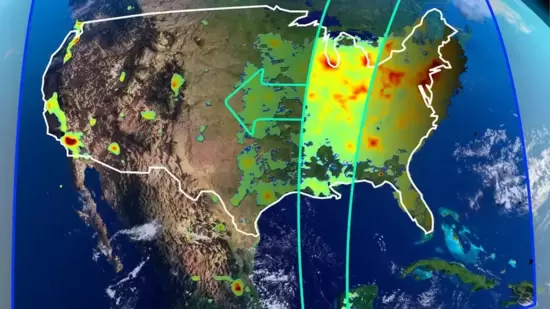Description

Disclaimer: Copyright infringement not intended.
Context
- NASA's new satellite to hourly measure air pollution hourly has shown significant progress and now the space agency officials are already thinking about ways to extend its life.
- TEMPO is NASA’s first Earth-observation satellite in geostationary orbit and has developed further from previous polar-orbiting satellites provided daily observations to provide 10 to 12 daily scans.
Details
Mission and Objectives
- Purpose: TEMPO is a space-based ultraviolet–visible spectrometer designed to monitor air pollution across greater North America.
- Measurements: It provides high-resolution, hourly data on atmospheric pollutants like ozone, nitrogen dioxide, and formaldehyde.
Instrumentation and Operation
- Spectrometer Design: TEMPO's ultraviolet–visible spectrometer measures reflected sunlight from the Earth's atmosphere and dissects it into 2,000 component wavelengths.
- Geostationary Host: Hosted as a payload on a commercial geostationary communication satellite, TEMPO maintains a constant view of North America.
- Coverage Area: Scans the region from the Pacific Ocean to the Atlantic Ocean and from the Alberta oil sands to Mexico City.

Constellation and Collaborations
- Geostationary Constellation: TEMPO contributes to a constellation of pollution-monitoring assets, including ESA's planned Sentinel-4 and South Korea's Geostationary Environment Monitoring Spectrometer (GEMS).
- Partnerships: Developed as a collaboration between NASA and the Smithsonian Astrophysical Observatory.
Integration and Launch
- Host Satellite: TEMPO resides on the Intelsat 40e satellite, built by Maxar Technologies, responsible for payload integration.
- Launch Date: It was sent aloft in April and built by Ball Aerospace.
Program
- Earth Venture-Instrument Program: TEMPO is NASA's inaugural Earth Venture-Instrument (EVI) mission.
- EVI's Role: Part of NASA's Earth System Science Pathfinder (ESSP) program office, supporting innovative, low-cost missions driven by scientific research and applications.
- Competitive Selection: Selected through competitive solicitations, EVI missions address various areas of Earth science.
Other Earth Venture Missions
- Nature of Missions: EVI missions are characterized as small-sized, competitively selected orbital missions or instrument missions of opportunity.
- Examples: Include missions like NASA-ISRO Synthetic Aperture Radar (NISAR), Surface Water and Ocean Topography (SWOT), ICESat-2, and others like Gravity Recovery and Climate Experiment Follow On (GRACE-FO), Cyclone Global Navigation Satellite System (CYGNSS), and Ecosystem Spaceborne Thermal Radiometer Experiment on Space Station (ECOSTRESS), among others.
Future Prospects
- Extended Lifespan Goals: While initially planned for a 20-month operation, NASA and Intelsat are aiming for an extended functionality of 10-15 years for TEMPO.
- Precursor for Future Missions: TEMPO's success sets the stage for NOAA's enhanced Atmospheric Composition Instrument, slated for a mid-2030s launch.

Conclusion
TEMPO's role as part of the EVI program showcases NASA's commitment to innovative, cost-effective missions focusing on Earth science research and applications, particularly in monitoring and understanding air pollution over North America.
|
PRACTICE QUESTION
Q. Which among the following statements regarding the TEMPO satellite is correct?
A) TEMPO is a polar-orbiting satellite designed for high-resolution mapping of Mars' atmosphere.
B) It measures air pollution over North America on a daily basis using infrared imaging technology.
C) TEMPO is a geostationary Earth-observation satellite providing hourly data on atmospheric pollutants like ozone, nitrogen dioxide, and formaldehyde.
D) It collaborates with the European Space Agency's Sentinel-5P for monitoring oceanographic parameters.
Correct Answer: C)
|















